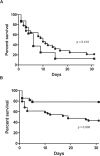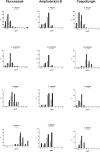Candidemia in the elderly: What does it change?
- PMID: 28493896
- PMCID: PMC5426612
- DOI: 10.1371/journal.pone.0176576
Candidemia in the elderly: What does it change?
Abstract
Background: Candidemia is a life-threatening fungal infection and it can affect patients of all ages. Characterization of candidemia in the elderly is lacking.
Methods: We performed a retrospective study of adults (≥ 18 years) with candidemia diagnosed in our center in 2010-2015. Demographics, comorbidities, clinical and microbiologic characteristics, antifungal treatment and outcome were compared between older (≤65 years) and younger (>65 years) patients.
Results: Among 302 patients with candidemia identified during the study period, 188 (62%) belonged to the elderly group. Comorbidities were significantly more frequent in older patients and included chronic pulmonary diseases, cardiovascular diseases, diabetes mellitus, and chronic renal failure (p ranging from <0.0001 to 0.017). A significantly higher proportion of older patients had septic shock (p = 0.040) at the time of candidemia. Candida albicans accounted for 53% of isolates and there were no significant differences between patients' age and Candida species. Thirty-day mortality was significantly higher in older (45%) than in younger (28%) patients (p = 0.003). Factors associated with a significant higher proportion of death in the elderly included older age (i.e.: old-old), being hospitalized in ICU rather than in other wards, suffering from chronic pulmonary diseases, the presence of septic shock, multiple organ failure, dialysis and being infected with C. glabrata (p ranging from <0.0001 to 0.034). On multivariate analysis septic shock (HR 1.744 [CI95% 1.049-2.898], p = 0.032) and multiple organ failure (HR 2.242 [CI95% 1.070-4.698], p = 0.032) were independently associated with a higher risk of death. The probability of 30-days survival of older patients was significantly reduced when compared to that of younger patients (p = 0.005) who did not receive any treatment. In the elderly, there was a trend toward higher MICs for fluconazole/C. albicans, fluconazole/C. glabrata, amphotericin B/C. albicans, and caspofungin/C. glabrata.
Conclusions: In our study, we found that elderly patients with Candida bloodstream infections are characterized by a high mortality rate. In particular, the lack of any antifungal therapy as well as the occurrence of septic shock increased significantly the overall mortality. Additionally, we found that there was a trend of higher MIC for specific drug/Candida combination.
Conflict of interest statement
Figures


References
-
- Diekema DJ, Messer SA, Brueggemann AB, Coffman SL, Doern GV, Herwaldt LA, et al. (2002) Epidemiology of candidemia: 3-year results from the emerging infections and the epidemiology of Iowa organisms study. J Clin Microbiol 40:1298–1302. doi: 10.1128/JCM.40.4.1298-1302.2002 - DOI - PMC - PubMed
-
- Pappas PG, Rex JH, Lee J, Hamill RJ, Larsen RA, Powderly W, et al. (2003) A prospective observational study of candidemia: epidemiology, therapy, and influences on mortality in hospitalized adult and pediatric patients. Clin Infect Dis 37:634–643. doi: 10.1086/376906 - DOI - PubMed
-
- Tortorano AM, Peman J, Bernhardt H, Klingspor L, Kibbler CC, Faure O, et al. (2004) Epidemiology of candidaemia in Europe: results of 28-month European Confederation of Medical Mycology (ECMM) hospital-based surveillance study. Eur J Clin Microbiol Infect Dis 23: 317–322. doi: 10.1007/s10096-004-1103-y - DOI - PubMed
-
- Pfaller MA, Diekema DJ (2007) Epidemiology of invasive candidiasis: a persistent public health problem. Clin Microbiol Rev 20:133–163. doi: 10.1128/CMR.00029-06 - DOI - PMC - PubMed
-
- Nucci M, Queiros-Telles F, Tobon AM, Restrepo A, Colombo AL. (2010) Epidemiology of opportunistic fungal infections in Latin America. Clin Infect Dis 51:887–895. - PubMed
MeSH terms
Substances
LinkOut - more resources
Full Text Sources
Other Literature Sources

